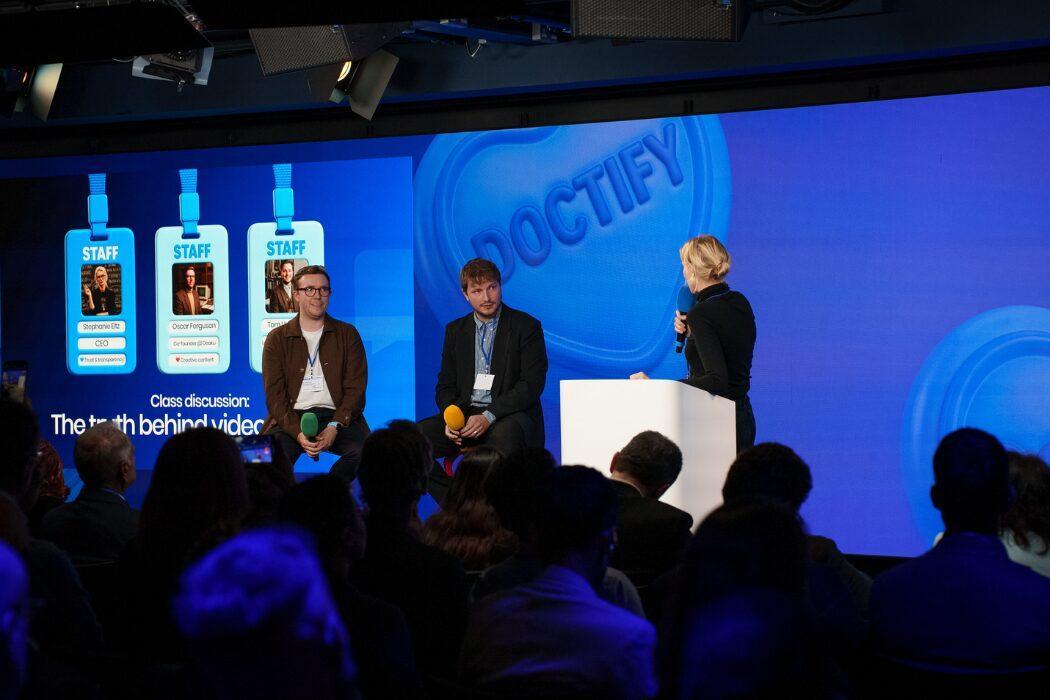In today’s digital age, wherever you look, people are lost in their smartphones, swiping through social media feeds, consuming content, and seeking answers online. This trend extends to healthcare, where an increasing number rely on the internet for advice. In fact, around 7% of Google’s daily searches are health-related. That’s approximately 70,000 searches every minute on various health topics, spanning from conditions and medications to symptoms and insurance queries.
But the high volume of medical queries isn’t experienced just by Google. YouTube, the second largest search engine, also reports a surge in demand for health-related videos, with a staggering total of 3 billion views in the UK and 110 billion globally in 2022.
As the demand for accessible healthcare information continues to rise, recent findings from an NHS survey are telling: an impressive 93% of clinicians acknowledge the value of video content in aiding patient understanding. In line with this, we teamed up with YouTube Health to host an event aimed at empowering healthcare professionals to embrace content creation as an avenue to share their expertise. Our mission? To make it easier for patients to find verified information about their conditions or treatments, enabling them to make well-informed decisions about their care.
Why clinicians should consider creating content online
Our first event at the Google HQ in London brought together over 300 healthcare professionals, all enthusiastic about exploring the realm of video content and its pivotal role in establishing patient trust. Some of them were newcomers to video creation, but they were keen to learn about producing evidence-based content that is easily accessible online for people researching healthcare. They received insights from our fantastic panel of clinician creators and speakers, including Dr James O’Donovan, Dr Karan Rajan, Dr Liz O’Riordan, and Dr Aziza Sesay, as well as Dr Vishaal Virani, Head of Health Partnerships at YouTube UK & Ireland, and Dr Suman Saha, Doctify’s Co-founder and Medical Director.
During the discussion, an important trend was highlighted: since the pandemic, people are 3.5 times more likely to educate themselves about health issues. However, this surge in self-education also poses the risk of encountering misinformation from non-experts. This means healthcare professionals have a unique opportunity to share their expertise in the form of video, reaching those seeking reliable information. Such content is particularly valuable for vulnerable and hard-to-reach populations, offering them trustworthy guidance on healthcare matters.

1. 8 in 10 people come across fake news
Social media allows anyone to create accounts and share content, leading to a flood of unverified information. With 80% of people regularly coming across fake news, this poses a significant risk in healthcare, where people might follow advice from non-professionals, potentially worsening their health.
For instance, during the pandemic, a widespread misconception circulated globally, suggesting that consuming highly concentrated alcohol could disinfect the body and eradicate the virus. Tragically, this misinformation led to dire consequences. According to a study in the American Journal of Tropical Medicine and Hygiene, around 800 fatalities occurred due to this myth. Furthermore, 5,876 individuals were hospitalised, and 60 people suffered complete blindness after ingesting methanol in an attempt to cure COVID-19.
Dr Karan Rajan, an NHS Surgeon and Health Content Creator, shared that his decision to educate the public was largely driven by the rampant misinformation during the COVID-19 pandemic. He came to realise that misinformation permeates every aspect, niche, and subspecialty within medicine and science. “There are influencers who lack expertise in areas such as gut health, yet they advocate for probiotics, supplements, coffee enemas, or colonics, which can ultimately result in people ending up in hospitals or even requiring surgical procedures,” he explained.
2. A 30-second video can save someone’s life
To some, content creation may seem unnecessary. After all, healthcare professionals are not influencers, and their primary role is saving lives and improving health. However, as highlighted by Dr Vishaal Virani, information plays a crucial role in determining health outcomes and can even be a matter of life and death. Therefore, ensuring access to high-quality information has a profound and long-term impact on individuals’ health.
As an example, Dr Virani shared a comment left on one of Dr James O’Donnovan’s videos titled “6 Signs and Symptoms of Bowel Cancer”, where a viewer expressed, “I’m having my bowel cancer operation […]. If it were not for one of these videos I would have not got myself checked out.” This testimonial illustrates the significant impact healthcare professionals can have by sharing insightful and easily digestible content online.
Dr Karan Rajan shared a similar impactful story during the event. He talked about a patient who had symptoms that could indicate bowel cancer but was anxious about their health and didn’t want to see a doctor. However, after watching Dr Rajan’s video, the patient felt more confident and decided to get checked. The doctor arranged a colonoscopy quickly, which led to the diagnosis of bowel cancer. Thankfully, the patient had successful surgery and is now cancer-free. Dr Rajan’s video played a big part in this happy outcome, showing how healthcare professionals’ online content can make a real difference in people’s lives.
“The metric that matters most is not the million followers or the million likes, or anything like that. Those are just fancy metrics. The metric that matters is having an impact on just one person.”
Dr Karan Rajan, NHS Surgeon and Health Content Creator.
Similarly, Dr Aziza Sesay, a General Practitioner and Health Content Creator, shared her own experience of leveraging short videos to dispel misconceptions and encourage life-saving actions among her patients. By creating brief videos illustrating the cervical screening process, which take just 30 seconds for patients to watch, she successfully alleviated their concerns and motivated them to undergo the essential test.
These examples highlight the transformative potential of healthcare professionals’ online content in promoting health awareness and driving positive health outcomes.

3. Transforming lives worldwide, one click at a time
The impact of distributing your online content resonates far beyond screens – it has the power to transform lives worldwide. Whether you’re reaching millions or just one person in a vulnerable position who lacks access to healthcare, your video can offer them guidance and support they might not find elsewhere. With social media platforms spanning the globe, your reach extends to individuals in diverse corners of the earth, presenting a unique opportunity to create positive change on a large scale.
Dr James O’Donnovan shared, “Thirty percent of my audience is in India, and one of the huge taboos there is sexual health issues. I get millions of views on some of my sexual health videos, and some of the comments have been really heartwarming. Some people have said, ‘I’ve never wanted to speak to anyone about this, and this video has saved me from years and years of depression.’”
This is just one example among many of how healthcare professionals are leveraging digital platforms to make a tangible difference in the lives of individuals across the globe. Whether it’s breaking down misconceptions, encouraging proactive health behaviours, or providing support and guidance, the impact of their efforts is profound and far-reaching. And as previously mentioned by Dr Karan Rajan, it’s not about the numbers – it’s about the meaningful impact on individual lives that truly defines the value of reaching millions in the digital sphere.
YouTube makes it easier for patients to verify health videos
In the vast sea of online content, where anyone can upload videos, verifying health information can be challenging, especially for those without medical expertise. That’s where YouTube’s solution comes in handy with its YouTube Health features. As a healthcare professional, you can utilise these tools to position your channel as a trusted source of health information. Once approved, your videos will showcase an information panel verifying your medical credentials. Additionally, they may appear in health-related searches, ensuring that individuals researching healthcare content find reliable information right from the start.

Every video published by Dr Liz O’Riordan has a verification badge that confirms her credentials, ensuring viewers that the information provided is from a trusted and qualified source.
Lights, camera, action!
When embarking on your content creation journey, it’s tempting to procrastinate while waiting for the perfect camera or lighting setup. However, as Dr Karan Rajan pointed out, “People love raw and authentic content. If you have an iPhone, you can film something.”
So, start by creating short, insightful videos that address common patient questions, explain symptoms, various conditions, and discuss treatments. You can then share your videos across diverse platforms like YouTube, Instagram, TikTok, LinkedIn, and Doctify to broaden your reach and connect with potential new patients.
💡Bonus tip: Integrate these videos into your internal patient communications to enrich their experience and empower them with knowledge to make informed healthcare decisions.

Mr Vik Veer, ENT Surgeon and Healthcare Content Creator, exemplifies the power of a Doctify profile by providing transparent reviews and valuable content for patients researching his care.
This curated content not only aids patients in assessing whether you’re the right clinician for their needs but also allows them to connect with your personality, boosting their confidence in choosing you as their healthcare provider. “It’s such a great opportunity for patients to preview their doctor’s personality before their visit”, said Dr Aziza Sesay.
We’ve witnessed remarkable outcomes on the Doctify platform from incorporating a brief 30-second introduction video into profiles, with patients being six times more likely to select a provider after viewing a personalised video. This shows the significant impact that multimedia content can have in building trust and fostering meaningful patient-provider relationships.
Look out for the next blog with top tips on how to create a successful YouTube channel and captivating content.
Ready to create a powerful professional profile in healthcare to build patient trust?





